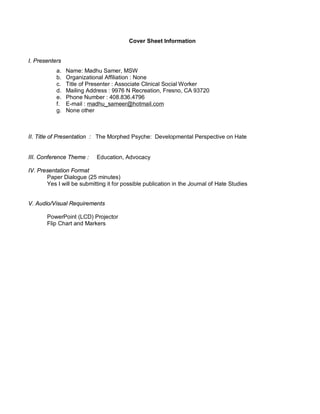Abstract the morphed psyche
- 1. Cover Sheet Information I. Presenters a. Name: Madhu Samer, MSW b. Organizational Affiliation : None c. Title of Presenter : Associate Clinical Social Worker d. Mailing Address : 9976 N Recreation, Fresno, CA 93720 e. Phone Number : 408.836.4796 f. E-mail : madhu_sameer@hotmail.com g. None other II. Title of Presentation : The Morphed Psyche: Developmental Perspective on Hate III. Conference Theme : Education, Advocacy IV. Presentation Format Paper Dialogue (25 minutes) Yes I will be submitting it for possible publication in the Journal of Hate Studies V. Audio/Visual Requirements PowerPoint (LCD) Projector Flip Chart and Markers
- 2. Gonzaga Institute for Hate Studies, Second International Conference on Hate Studies, Spokane, April 6 ¨C 9, 2011 A Morphed Psyche : Developmental Perspectives on Hate Abstract The presentation explores the phenomenon of hate from a developmental perspective, using depth psychological approach to create a felt experience of the etiology of hate in the audience. The exploration covers the first experiences in the tender psyche of the infant, and how the memory trace of hatred is created, nurtured, maintained, displaced, rewarded and promoted internally by the ego and also ¨C consciously and unconsciously - through socio-politico-cultural impositions in contemporary societies. The exploration of the etiology of hate as a compensatory phenomenon that simply arises of a need to rebalance the internal and external worlds, is supplemented by presenters personal experiences of being an ethnic minority, and clinical case vignettes that represent a microcosm of the larger world. The paper concludes by suggesting strategic policy reforms that may help stem the malaise that now threatens to outgrow the positive human emotions in American as well as the world psyche.
- 3. Summary Psychology professionals intellectualise, analyze and organize all experiences in an effort to create predictive validity around observed phenomenon. However, the lived experiences, subjective as they may be, provide a deeper meaning, even though such experiences may represent chaos and unpredictability. But unpredictability and internal chaos is precisely what drove Hitler, Osama Bin Ladin, and many before them, to hate and violence and no amount of intellectualzation and cognitive rationalization can realistically understand their actions. Hence there exists an urgent need to explore the felt emotions as they are experienced by the individual or collective psyche, with an understanding that hate, and associated emotions, cannot be otherwise contained, not even in their taxonomies! Whereas negative emotions represent unsatisfied quests for power and control, at the same time and on another level, they also represent an underlying vulnerability that yearns for progress, for safety, for protection and dependency. In that sense hate is originally born of the same tender sensibility that guides the emotion of love. All of us are capable of envy, rage and hate and have experienced and continue to experience these emotions in varying degrees at various points in our day to day living. If we are lucky, our developmental framework has provided us with tools that will be able to contain these emotions successfully. For the rest of us, the lack of a soothing developmental container leaves us vulnerable to the harsh desertland of hatred. Being able to tap into our own emotional reservoir creates an empathic vantage point from which we can compassionately observe and intervene in cases where psychic balanced has been morphed by hate. Negative emotions of hate, like dreams, art and music, are best understood when approached from the paradigm of alternative, non ordinary states of altered consciousness, a different state of reality where personality shifts may temporarily occur. These states break free of ego-complexes, and compel, and impel us in different directions. Often these states embody re-enactment of earlier traumatic events. The psychological understanding of these non ordinary states of mind in others lies in our own ability to develop sensibilities that can experience the purpose, and the underlying developmental tasks these emotions attempt to accomplish in the people who are innately compelled to live these burdensome states of existence. By providing an avenue to realize those developmental milestones thru less destructive means, hatred can be contained and transformed into positive emotions that bring motivation, inspiration and healing.
- 4. The paper uses developmental theories of depth psychology, case studies and presenterˇŻs personal experiences of being at both ends of the dislike/hate paradigm, to create an awareness how hate and acts of hate are usually a reaction to a deeper, earlier wounding that go back to the infancy stages. The infant first learns to hate when the comfort it seeks from the mother is not forthcoming. These earliest memories form a groove on which the later disappointments and disillusionments of life fall. They feed the primal wounding and keep it alive. The phenomenon of hate appears to have definite implied goals of formation of internal psychological structures that aid survival. The paper explores the role of early attachments, and its relationship to building a tolerant community and concludes with suggestions for socio-political reforms that may allow the psyche of the individuals in our society, our nation and the world community to be able to transcend emotional extremes and relinquish all one sided approaches thru transmutation of the opposites, choosing to remain in the middle by following a neutral path that rewards with balance, unity and peace.





